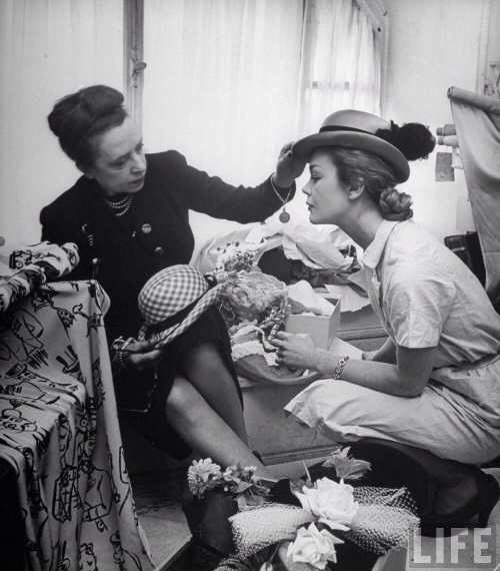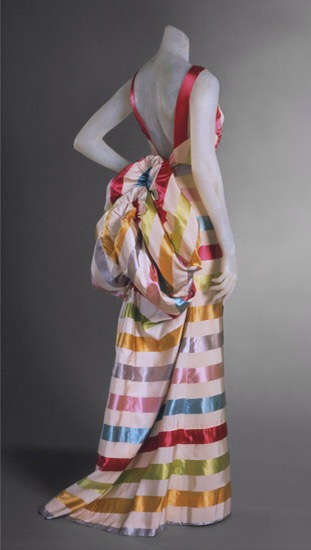“in difficult times, fashion is always outrageous”
in the 1930s one of the most prominent couture designers was an Italian woman by the name of Elsa Schiaparelli. Schiaparelli’s designs were heavily influenced by Surrealists such as Salvador Dalí and Jean Cocteau. however, Schiaparelli did not adapt to the changes in fashion following the WW2 resulting in her couture house closing in 1954. one of her most famous designs was her lobster dress, Anna Wintour once wore a dress paying homage to the forgotten designer.
the 1937 Lobster Dress was a white silk evening dress with a right, wide waistband featuring a large lobster painted by Dalí on the skirt.his design for Schiaparelli was interpreted into a fabric print by the leading silk designer Sache. It was famously worn by Wallis Simpson in a shoot by Cecil Beaton taken at the Château de Candé shortly before her marriage to Edward VIII.
Schiaparelli’s design career was early on influenced by couturier Paul Poiret (a highly influential designer at the end of the 1900s), who was renowned for jettisoning corseted, over-long dresses and promoting styles that enabled freedom of movement for the moder woman. in later life, Schiaparelli referred to Poiret as “a generous mentor, dear friend.”
Schiaparelli had no training in the technical skills of pattern making and clothing construction. her method of approach relied on both impulse of the moment and the serendipitous inspiration as the work progressed. she draped fabric directly on the body, sometimes using herself as the model. this technique followed the lead of Poiret who too had created garments by manipulating and draping.
whilst in Paris, Schiaparelli began making her own clothes. With encouragement from Poiret, she started her own business but it closed in 1926 despite favourable reviews. she launched a new collection of knitwear in early 1927 using a special double layered stitch created by Armenian refugees and featuring sweaters with surrealist trompe l’oeil images. although her first designs appeared in Vogue, the business really took off with a pattern that gave the impression of a scarf wrapped around the wearer’s neck. the “pour le Sport” collection expanded the following year to include bathing suits, ski-wear, and linen dresses. Schiaparelli added evening wear to her collections in 1931, using the luxury silks of Robert Perrier, and the business went from strength to strength.
 the Tears Dress, a slender pale blue evening gown printed with a Dalí design of trompe l’oeil rips and tears, worn with a thigh-length veil was part of the February 1938 Circus Collection. the print was intended to give the illusion of torn animal flesh, the tears printed to represent fur on the reverse of the fabric and suggest that the dress was made of animal pelts turned inside out.Richard Martin saw the Tears Dress as a memento mori produced in response to the Spanish Civil War and the spread of Fascism, declaring that to “tear the dress is to deny its customary decorum and utility, and to question the matter of concealment and revelation in the garment.”
the Tears Dress, a slender pale blue evening gown printed with a Dalí design of trompe l’oeil rips and tears, worn with a thigh-length veil was part of the February 1938 Circus Collection. the print was intended to give the illusion of torn animal flesh, the tears printed to represent fur on the reverse of the fabric and suggest that the dress was made of animal pelts turned inside out.Richard Martin saw the Tears Dress as a memento mori produced in response to the Spanish Civil War and the spread of Fascism, declaring that to “tear the dress is to deny its customary decorum and utility, and to question the matter of concealment and revelation in the garment.”
Soon after the fall of Paris on 14 June 1940, Schiaparelli sailed to New York for a lecture tour; apart from a few months in Paris in early 1941, she remained in New York City until the end of the war On her return she found that fashions had changed, with Christian Dior’s “New Look” marking a rejection of pre-war fashion. The house of Schiaparelli struggled in the post-war period, and Elsa finally closed the couture house down in December 1954, the same year that her great rival Chanel returned to the business.
Schiaparelli was one of the first designers to develop the wrap dress, taking inspiration from aprons to produce a design that would accommodate and flatter all female body types. Her design, which first appeared in 1930, offered a two-sided model with armholes on each side, brought together in the front of the garment and wrapped and tied at the waistline. Buttons may also have been incorporated into this early version. In 1931, Schiaparelli’s divided skirt – a forerunner of shorts, shocked the tennis world when worn by Lili de Alvarez at Wimbledon in 1931.
Other innovations included a swimsuit design which incorporated an interior bra with an alluring low-cut back by using hidden straps that crossed in the back and closed around the waist. This design was patented in 1930 and retailed by Best & Company. Also in 1930, she is credited with having produced the first evening dress with a matching jacket.
Schiaparelli was also renowned for her unusual buttons, which could resemble candlesticks, ships, crowns and mirrors or silver tambourines and silk-covered carrots and cauliflowers. Many of these fastenings were designed by Jean Clemént and Roger Jean-Pierre who also created jewellery for her.
One of her most directly Surrealist jewellery designs was a 1938 Rhodoid (a newly developed clear plastic) necklace studded with coloured metallic insects by Clément giving the illusion that the bugs were crawling directly on the wearer’s skin.nDuring the 1930s her jewellery designs were produced by Schlumberger, Clemént and Jean-Pierre, who also made up designs for buttons and fasteners. Compared to her unusual couture 1930s pieces, 1940s and 1950s Schiaparelli jewellery tended to be more abstract or floral-themed.





